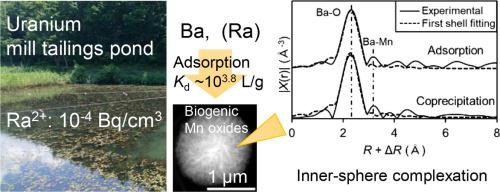Gondwana Research ( IF 6.1 ) Pub Date : 2021-10-04 , DOI: 10.1016/j.gr.2021.09.020 Hiroki Yokoo 1 , Takumi Oki 1 , Motoki Uehara 1 , Ilma Dwi Winarni 1 , Keiko Yamaji 2 , Kenjin Fukuyama 3 , Yoshiyuki Ohara 3 , Toshihiko Ohnuki 4 , Michael F. Hochella 5, 6 , Satoshi Utsunomiya 1

|
Biogenic Mn oxides are reactive and ubiquitous in many Earth surface environments, yet their role in radionuclide sequestration at U mill-tailings sites still require an improved understanding at the nano- and molecular-scales. This study concerns the uptake of Ba, utilized as a safe and chemically appropriate surrogate for radioactive Ra, by biogenic Mn oxides produced by a fungal species, Coprinopsis urticicola, isolated from the mine water of the Ningyo-toge U mine, Okayama, Japan. The biogenic Mn oxides were identified as birnessite nanocrystals <10 nm in width having many vacancy sites in the MnO6 octahedral layers. Ba2+ adsorption experiments using biogenic birnessite were conducted at pH 6.00±0.02 with the initial Ba concentrations ranging from 10–8 to 10–3 mol/L. The apparent distribution coefficient, Kd, was calculated to be 103.8 L/g for biogenic birnessite, which is comparable to the apparent Kd of Ra in the mill tailings pond at Ningyo-toge. Both in adsorption and coprecipitation experiments, extended X-ray absorption fine edge structure analysis of Ba L3 edge revealed that the Ba atom forms an inner-sphere complex with O atoms of the MnO6 layer. A slightly greater coordination number for coprecipitated Ba may be attributed to the formation of Ba–O binding to the newly overlying MnO6 layer during coprecipitation. Static desorption experiments for 7 days reveal that the steady-state release rate of adsorbed Ba is ∼1.4 times faster than that of the coprecipitated Ba, when the Ba concentration in the initial loading solution was ∼10–8 mol/L, indicating that the release of intercalated (coprecipitation) Ba to solution is retarded. The present study demonstrates the importance of fungus-generated Mn oxides as an efficient absorber of Ba2+, and likely Ra2+, among soil compounds in U mill-tailings. This may be applicable to other contaminated sites due to the ubiquitous occurrence of fungi in the environment.
中文翻译:

与真菌菌株产生的生物氧化锰纳米粒子相关的钡离子的地球化学:对铀厂尾矿中镭封存的影响
生物锰氧化物在许多地球表面环境中具有反应性和普遍性,但它们在 U 磨尾矿场的放射性核素封存中的作用仍然需要在纳米和分子尺度上得到更好的理解。这项研究涉及 Ba 的吸收,用作放射性 Ra 的安全和化学上合适的替代物,由真菌物种产生的生物锰氧化物,Coprinopsis urticicola,从日本冈山 Ningyo-toge U 矿的矿井水中分离。生物源Mn氧化物被鉴定为宽度<10nm的水钠锰矿纳米晶体,在MnO 6八面体层中具有许多空位。使用生物水钠锰矿进行Ba 2+吸附实验在 pH 6.00±0.02 下进行,初始 Ba 浓度范围为 10–8至 10 –3 mol/L。生物水钠锰矿的表观分配系数K d计算为 10 3.8 L/g,与Ningyo-toge 磨机尾矿池中 Ra的表观K d相当。在吸附和共沉淀实验中,Ba L 3边缘的扩展 X 射线吸收精细边缘结构分析表明,Ba 原子与 MnO 6层的O 原子形成球内复合物。共沉淀 Ba 的配位数稍大可能是由于形成了 Ba-O 与新上覆的 MnO 6 结合共沉淀过程中的层。7 天的静态解吸实验表明,当初始加载溶液中的 Ba 浓度为~10 –8 mol/L 时,吸附 Ba 的稳态释放速率比共沉淀 Ba 快~1.4 倍,表明插入的(共沉淀)Ba 释放到溶液中被延迟。本研究证明了真菌产生的 Mn 氧化物作为U 磨尾矿中土壤化合物中Ba 2+和可能的 Ra 2+的有效吸收剂的重要性。由于环境中普遍存在真菌,这可能适用于其他污染场地。

























 京公网安备 11010802027423号
京公网安备 11010802027423号